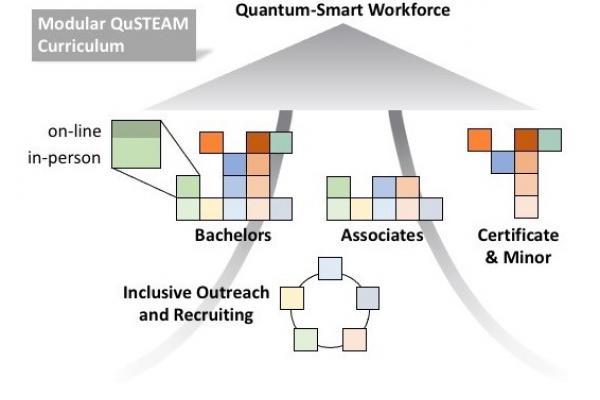IOS Member, Zeke Johnston-Halperin, is leading a NSF funded initiative to develop an undergraduate curriculum in QIS

The Ohio State University is the lead institution in a new educational initiative being launched through the National Science Foundation Convergence Accelerator program. The initiative is titled QuSTEAM: Convergent undergraduate education in Quantum Science, Technology, Engineering, Arts, and Mathematics and is focused on developing a revolutionary undergraduate curriculum that will provide a national educational model for the emerging field of quantum information science and technology (QIST) that incorporates inclusiveness and convergent disciplinarity from the ground up. The program is led by Prof. Ezekiel Johnston-Halperin (Physics), with Prof. Andrew Heckler (Physics) serving as one of 4 coPIs and Associate Professor Edward Fletcher (Educational Studies), Assistant Professors David Delaine (Engineering Education), and Emily Dringenberg (Engineering Education), Assistant Professor of Practice Zahra Atiq (Computer Science and Engineering), and Dr. Chris Porter (Physics) serving as Senior Personnel. The team consists of 19 faculty across 5 universities (Ohio State, Chicago State, U. of Chicago, U. of Illinois, and Michigan State) and Argonne National Laboratory in disciplines including Art, Business, Chemistry, Computer Science, Electrical and Computer Engineering, Math, Philosophy, and Physics. Founding industrial partners include Applied Materials, HRL, and IBM.
Phase 1 of the QuSTEAM program (funded at $700,000 over 9 months) will use research-based educational development strategies, including focus groups and surveys of academic, industrial, and national lab stakeholders, to determine the scientific and engineering practices that will be required of the future quantum smart workforce. This work will lay the foundation for Phase 2 activities in which this framework is built out into modules that can be recombined and repurposed to meet diverse educational needs, including future quantum professionals and members of the current industrial workforce, community colleges, minority-serving institutions, and other bachelors and doctoral degree-granting institutions. Modules will be built using in-person, online, and hybrid delivery modalities to enable the incorporation of content and instruction from multiple universities, industrial partners, and national lab participants.
Creating a quantum smart workforce will have a transformative effect on the US economy and society. The development of the QuSTEAM curriculum will support and accelerate the process of this development by setting national standards for the 71% of the STEM workforce that does not require a post-graduate degree. The combination of high-quality, engaging courses and multiple tracks will allow for multiple pathways for students with a range of backgrounds and interests. This inclusive approach to curriculum design will provide substantial leverage for increasing the participation of underrepresented groups in QIST, a subfield that currently lags even the modest diversity standards of its parent disciplines. The close interaction with practicing scientists and engineers will also help students identify and engage with concrete career paths that help improve retention. The QuSTEAM curriculum, and our methodology in developing it, will be made publicly available to serve as a template for the development of convergent curricula in other subjects.
Figure 1 Schematic of the modular QuSTEAM curriculum. Individual modules may be recombined and repurposed for different educational goals, and the hybrid on-line/in-person format allows for co-instruction across multiple institutions.
Read more: Ohio State-led QuSTEAM initiative to transform U.S. quantum education
